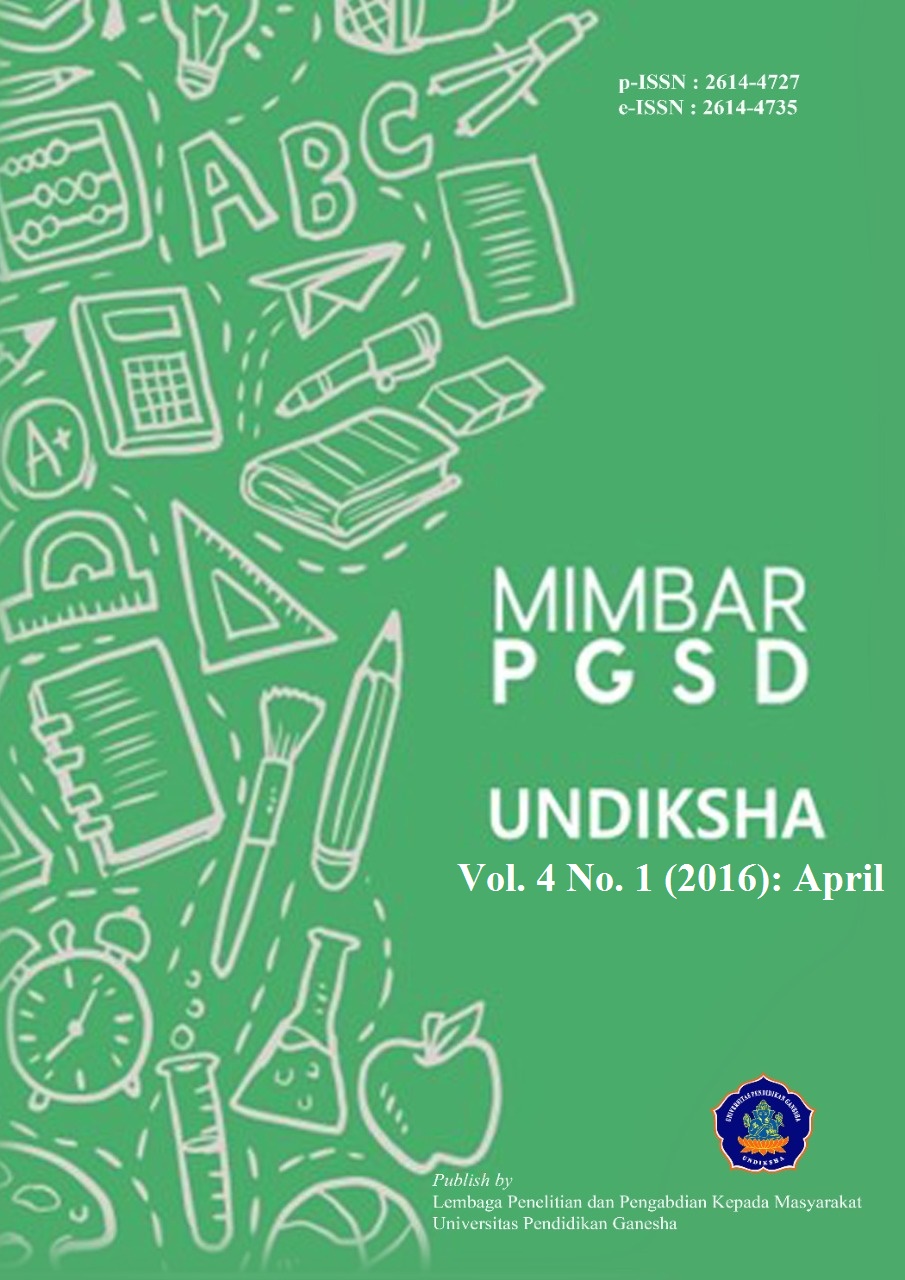PENGARUH MODEL COURSE REVIEW HORAY BERBANTUAN MULTIMEDIA TERHADAP HASIL BELAJAR IPA SISWA KELAS V SD
DOI:
https://doi.org/10.23887/jjpgsd.v4i1.7467Abstract
Masalah utama penelitian ini adalah rendahnya hasil belajar IPA siswa kelas V di SD gugus II Kecamatan Seririt yang dibuktikan oleh nilai rata-rata kelas dibawah KKM dan guru masih menggunakan model pembelajaran konvensional. Oleh karena itu penelitian ini bertujuan untuk: (1) mengetahui deskripsi hasil belajar IPA siswa yang dibelajarkan dengan model pembelajaran kooperatif tipe Course Review Horay berbantuan multimedia, (2) mengetahui deskripsi hasil belajar IPA siswa yang dibelajarkan dengan model pembelajaran konvensional, (3) mengetahui perbedaan yang signifikan hasil belajar IPA antara kelompok siswa yang dibelajarkan dengan model pembelajaran kooperatif tipe Course Review Horay berbantuan multimedia dan kelompok siswa yang dibelajarkan dengan model pembelajaran konvensional siswa kelas V semester genap tahun pelajaran 2015/2016 di SD Gugus Genap Dharma Tula Kecamatan Seririt. Jenis penelitian ini adalah quasi experiment dengan rancangan post test only control group design. Jumlah populasi dalam penelitian ini adalah 127 siswa dan jumlah sampel sebanyak 72 orang siswa. Data hasil belajar IPA dikumpulkan menggunakan metode tes, dan dianalisis menggunakan statistik deskriptif dan statistik inferensial (uji-t). Hasil penelitian menunjukkan: (1) rata-rata hasil belajar IPA siswa kelompok eksperimen sebesar 23,325 berada pada kategori sangat tinggi, (2) rata-rata hasil belajar IPA siswa kelompok kontrol sebesar 16,379 berada pada kategori sedang, (3) terdapat perbedaan yang signifikan model pembelajaran kooperatif tipe Course Review Horay berbantuan multimedia terhadap hasil belajar IPA siswa kelas V Semester Genap Tahun Pelajaran 2015/2016 di SD Gugus II Kecamatan Seririt (thitung = 7,002 > ttabel = 1,994).Kata Kunci : model pembelajaran kooperatif tipe Course Review Horay, multimedia, hasil belajar.
The main problem of this research was student’s low result in science learning based on the class’s average value that under the KKM and teachers still used conventional learning model. Based on that explanation, this research was aimed to: (1) find out the description of student’s result in science learning who taught with cooperative learning model type course review horay using multimedia, (2) find out the description of student’s result in science learning who taught with conventional learning model, (3) find out the significant difference between the students who taught with cooperative learning model type course review horay using multimedia and who taught with conventional learning model at fifth grade of 2nd semester in academic year 2015/2016 in Gugus Dharma Tula of seririt district. This research was a quasi experiment research with post-test only control group design. The population of this research was 127 students and the samples were 72 students. The result of student’s learning in science was collected by using test method, and it was analyzed by using descriptive statistic and inferential statistic (t-test). The results of this research indicate: (1) the average of student’s result in science learning at experiment group is 23,325 which is in the very high category, (2) the average of student’s result in science learning at control group is 16,379 which is in the medium category, and (3) there is a significant difference of cooperative learning type Course Review Horay using multimedia on student’s result in science learning at fifth grade of 2nd semester in academic year 2015/2016 in Gugus Dharma Tula of Seririt district (thitung = 7,002 > ttabel = 1,994).
keyword : cooperative learning model type Corse Review Horay, multimedia, learning result.
Published
2016-07-14
How to Cite
., K. E. K., ., I. K. S. M., & ., D. M. S. M. (2016). PENGARUH MODEL COURSE REVIEW HORAY BERBANTUAN MULTIMEDIA TERHADAP HASIL BELAJAR IPA SISWA KELAS V SD. MIMBAR PGSD Undiksha, 4(1). https://doi.org/10.23887/jjpgsd.v4i1.7467
Issue
Section
Articles
License
Authors who publish with the Mimbar PGSD Undiksha agree to the following terms:
- Authors retain copyright and grant the journal the right of first publication with the work simultaneously licensed under a Creative Commons Attribution License (CC BY-SA 4.0) that allows others to share the work with an acknowledgment of the work's authorship and initial publication in this journal.
- Authors are able to enter into separate, additional contractual arrangements for the non-exclusive distribution of the journal's published version of the work (e.g., post it to an institutional repository or publish it in a book), with an acknowledgment of its initial publication in this journal.
- Authors are permitted and encouraged to post their work online (e.g., in institutional repositories or on their website) prior to and during the submission process, as it can lead to productive exchanges, as well as earlier and greater citation of published work. (See The Effect of Open Access)













